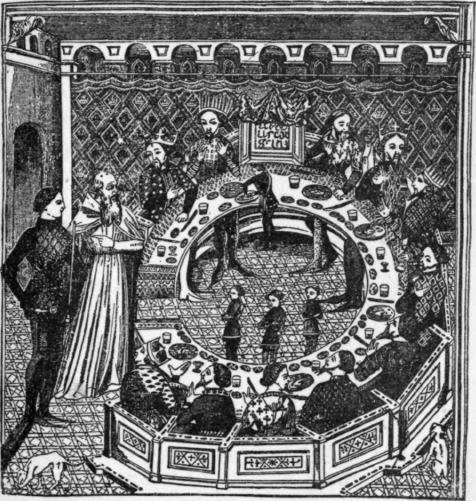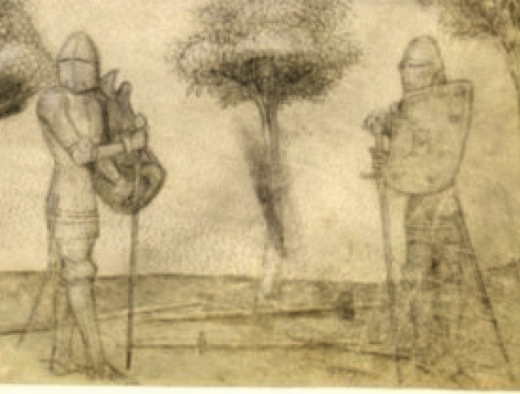Why
a Fellowship?
Every
student of the martial arts must live with the real consequences of how
they train, and with whom they train, not the good intentions of either.
By
John Clements
ARMA Director
 Any
collection of people, virtual or actual, can be called a community. But
what unites and bonds them? Is it just a common interest in or similar
attraction to martial arts? Or does what and how much you share depend
on whom and under what terms you share it? Any
collection of people, virtual or actual, can be called a community. But
what unites and bonds them? Is it just a common interest in or similar
attraction to martial arts? Or does what and how much you share depend
on whom and under what terms you share it?
What brings a student of historical fighting arts together with others?
Historically, this discipline, this craft, this noble science,
was never practiced as a vain leisure activity nor solely for individual
glory, but with recognition that as a warrior the fighting man was part
of a class, a caste, a brotherhood of arms. Whether as some order of feudal
knight or gentleman courtier, as scholar in a school of defence or fellow
in a fighting guild, learning and practicing the art of arms demanded
solidarity among practitioners. They were elites.
Though modern enthusiasts frequently like to imagine they can train alone
in their own “solo art,” it’s just not so. But, in the
same way that fighting skills are not practiced in a psychological vacuum
but with the need for mental and emotional control, a martial discipline
is not practiced in social isolation independent from the need to train
with (and exercise against) others. Indeed, many leading humanist educators
of the Renaissance stressed the martial arts as part of their curricula
specifically because they valued its capacity to help make a better citizen.
There is no question that, ultimately, self-defense is a highly personal
matter largely of self-effort — whether on the battlefield or the
street, in judicial combat or private duel of honor. But the knightly
art of arms was never really something to be practiced remotely in seclusion
or for some singular occasion, but with one's fellows—and not just
any fellows, but those whose honor was demonstrated and whose respect
had been earned. And among elites it can’t be any other way. Every
school had its rankings, every teacher his pupils, every knight his retainers,
every courtier his trusted band, every free man his militia. There was
no selfish “lone warrior” myth nor much truth to the knight
errant, and even the duel of honor was itself chiefly a matter of public
reputation among one's social peers. The Art as expressed in the Renaissance
source teachings, was taught with the recognition it was intended only
for those who were deemed worthy, those trustworthy to receive it. However
much this was followed in practice we can never really know. But those
who associated together to train under the same guild or teacher shared
fidelity with one other. In this way they could teach and demonstrate,
instilling in others a desire to learn the craft and a sense of accomplishment
in doing so.
Yet, there can be no question that not all martial arts (nor artists)
are created equal. They simply don’t all have equivalent understanding
of the innate biomechanics or the same repertoire of effective techniques.
They have their own “personalities” —entirely independent
from utility or effectiveness—and not every discipline is right for
every person. Today, different styles and different practitioners can
each have markedly different motives, objectives, and methods, as well
as distinct core assumptions about fighting. Each individual and group
today can vary widely in degree of “settled order of learning”
(to quote the late-15th century maestro Pietro Monte). Their focus may
be on different source works or masters, different primary weapons, different
historical periods, different degrees of athleticism or physicality, and
very different levels of effort and martial spirit, not to mention dissimilar
training standards and regulations. Which is why we catch people saying
insipid things like, “Even though I can’t make it work, my interpretation
of that technique is more accurate.”
People today often complain about the commercialization of martial arts
as a commodity, or its pretense and insincerity, while at the same time
they will decry the impersonal nature of much of modern life. And yet,
here we have with this craft a legacy that at once celebrates individual
achievement and awards personal effort while it simultaneously acknowledges
our shared connection to a renewed heritage. But somehow reviving its
traditional dedication to principle and honor gets either ridiculed or
trivialized.
Unselfishness is not a feature that immediately springs to mind in regard
to either historical research or the practice of a martial discipline.
But it is an aspect of cultural renewal and preservation of heritage.
So it is worth asking if your interest in the martial arts of Renaissance
Europe is a desire to share with others, or just the need to use them
for your own needs? Is not working to reconstruct and revive these lost
fighting systems far more than the meagerness of just finding someone
to practice with? Why even seek out others who share our passion if it
is not because of something more than just the mundane commonality of
collective curiosity? What does loose affiliation with strangers really
offer without commitment to a larger effort or greater ideas, let alone
any agreed method and standards?
 When you think about it, just because a group of loosely organized practitioners
says, “we are interested in X, we study Y and practice Z,” this
really doesn't give you a clue as to their agenda or who they really are
at heart. You may know their interest in the subject, but what’s
their interest in you or in one another? Join the typical established
dojo or other equivalent and you have essentially have one of two models
to follow: either be indoctrinated into revering another cultural tradition
with allegiance to its hierarchical order, albeit one packaged for modern
Western customers, or else casually embrace an informal structure that
asks no more loyalty than you would expect out of a college course on
accounting. Join up with a generic historical fencing group, on the other
hand, and you may have no idea what you are getting into or the character
and values of those you are getting in with. When you think about it, just because a group of loosely organized practitioners
says, “we are interested in X, we study Y and practice Z,” this
really doesn't give you a clue as to their agenda or who they really are
at heart. You may know their interest in the subject, but what’s
their interest in you or in one another? Join the typical established
dojo or other equivalent and you have essentially have one of two models
to follow: either be indoctrinated into revering another cultural tradition
with allegiance to its hierarchical order, albeit one packaged for modern
Western customers, or else casually embrace an informal structure that
asks no more loyalty than you would expect out of a college course on
accounting. Join up with a generic historical fencing group, on the other
hand, and you may have no idea what you are getting into or the character
and values of those you are getting in with.
What advantage is found without a deeper connection or meaningful responsibility
to one another through something more than informal ad hoc relationships?
Or do we reduce this reclaimed art to just trivial interest in a “mutual
activity,” like a hobby of stamp collecting or a generic sport of
cycling? When everyone is left to their own devices doing their own separate
thing in whatever way they imagine without a mutual direction or reciprocal
commitment, how then can that be considered a honest "community?"
That this craft is about self-improvement as well as mutual education
means it needs a genuine community—not the hollow networking of social
media or the self-centered shill of online banter, nor the pretentious
role-play of imaginary nobility, but an organized assemblage with real
principles and sincere values they work to realize together. There has
never been a great martial artist produced by committee. As a self-defense
art, this discipline is perhaps self-centered, and certainly self-preserving
and self-realizing. But it was never pursued selfishly or by deceiving
and exploiting one's fellows. It is through identification with the real
historical masters and fighting guilds that can we improve the craft and
ourselves. All of this is why petty politicking and commercialism is shunned within our guild.
Today, just as in the Renaissance era, those who seek others to train
with or a teacher to learn from must do so with a sense of camaraderie,
loyalty, ethics, and trust. Anything less disrespects our heritage and
works against the very ideals the Masters upheld. …History, heritage,
self-defense, and camaraderie. Who could argue with that?
See also:
The ARMA Credo
|

